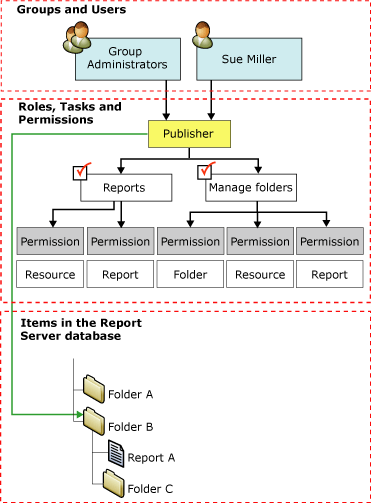Role assignments
In Reporting Services, role assignments determine access to stored items and to the report server itself. A role assignment has the following parts:
A securable item for which you want to control access. Examples of securable items include folders, reports, and resources.
A user or group account that Windows security or another authentication mechanism can authenticate.
Role definitions define a set of permissible tasks and include:
- Browser
- Content Manager
- My Reports
- Publisher
- Report Builder
- System Administrator
- System User
Role assignments are inherited within the folder hierarchy and are automatically inherited by contained:
- Reports
- Shared data sources
- Resources
- Subfolders
You can override inherited security by defining role assignments for individual items. At least one role assignment must secure all parts of the folder hierarchy. You can't create an unsecured item or manipulate settings in a way that produces an unsecured item.
The following diagram illustrates a role assignment that maps a group and a specific user to the Publisher role for Folder B.

System-level and item-level role assignments
Role-based security in Reporting Services is organized into the following levels:
Item-level role assignments control access to items in the report server folder hierarchy such as:
- reports
- folders
- report models
- shared data sources
- other resources
Item-level role assignments are defined when you create a role assignment on a specific item, or on the Home folder.
System role assignments authorize operations that are scoped to the server as a whole. For example, the ability to manage jobs is a system level operation. A system role assignment isn't the equivalent of a system administrator. It doesn't confer advanced permissions that grant full control of a report server.
A system role assignment doesn't authorize access to items in the folder hierarchy. System and item security are mutually exclusive. Sometimes, you might need to create both a system-level and item-level role assignment to provide sufficient access for a user or group.
Users and groups in role assignments
The users or group accounts that you specify in role assignments are domain accounts. The report server references, but doesn't create or manage, users and groups from a Microsoft Windows domain (or another security model if you're using a custom security extension).
Of all the role assignments that apply to any given item, no two can specify the same user or group. If a user account is also a member of a group account, and you have role assignments for both, the combined set of tasks for both role assignments are available to the user.
When you add a user to a group that already has a role assignment, you must reset Internet Information Services (IIS) for the new role assignment to take effect.
Predefined role assignments
By default, predefined role assignments are implemented that allow local administrators to manage the report server. You can add other role assignments to grant access to other users.
For more information about the predefined role assignments that provide default security, see Predefined roles.